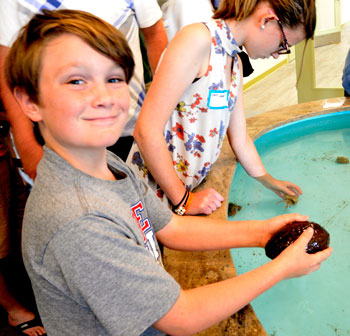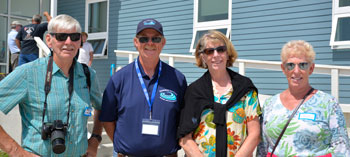DEI Cuts Ribbon on Nation’s Easternmost Marine Research Facility
by Sarah Craighead Dedmon

DEI’s new research facility includes a touch tank where area youth can interact with lobsters, crabs, razor clams, cod and even hold sea cucumbers. Photo by Sarah Craighead Dedmon
One fine Saturday in August a long string of cars wound their way from Route 1 into Jonesport, across the Beals Island Bridge, onto Great Wass Island, then down the quiet dirt road leading to the new home of the easternmost marine research facility in the United States.
The Downeast Institute cut the ribbon on its state-of-the-art $6.6 million expansion on August 11th in front of Congressman Bruce Poliquin, University of Maine President Dr. Joan Ferrini-Mundy, University of Maine Chancellor James H. Page and many of the original scientists and educators who helped bring it all to life in 1987.
“For those who like to measure time, that was 31 years, two months, and five days ago,” said Dr. Brian Beal from the podium where he recounted milestones that lined a path from a 4-H clam spawning program in 1983 to the steps of a marine research facility that will host scientists from the U.S. and beyond, building on the Downeast Institute’s (DEI) mission to “improve the quality of life for the people of Downeast and coastal Maine.”
Beal is a professor of marine ecology at the nearby University of Maine at Machias and the research director at DEI, which doubles as UMM’s Marine Field Station. Though DEI’s foundations were laid decades before warming waters sparked a population explosion in the soft-shell clam’s mortal enemies, those early hatchery experiments kicked off research that could defend today’s clam fishery from extinction at the claws of the green crab.
DEI doubles as
UMM’s Marine
Field Station.
“We’ll be able to look at the pH of water and see how that affects larval mussels or juvenile lobsters and get an idea of what we can do to get ahead of this thing,” said Kyle Pepperman, DEI Aquaculture Production and Research Assistant, and a graduate of UMM’s marine biology program.
The quest for funding began 18 years ago and picked up momentum quickly in 2014 when DEI submitted a simple, two-page application to the Next Generation Foundation of Maine. “It was the biggest ‘yes’ we’d ever gotten,” Beal said. The foundation contributed a whopping $2 million to the expansion effort. When that domino fell, said Beal, the rest of the funding fell into place.
They were able to use that money as a match for funds won through a 2014 Maine ballot measure, the Maine Marine Businesses Bond Issue. An additional $1.8 million came from the Harold Alfond Foundation, and after assuming the role of DEI’s first Executive Director in 2015, Dianne Tilton secured the last $800,000 through Maine’s New Market Tax Credit.

Beal, second from left, said a $2 million donation from the Next Generation Foundation opened the floodgates to secure the rest of the money needed for DEI’s expansion. Next Generation officers Brian Clough, Mary Offutt and Chantal Dukette attended the institute’s ribbon cutting event on Aug. 11. Photo by Sarah Craighead Dedmon
Moves like that earned her Beal’s undying gratitude.
“For me, having Dianne at the helm has meant the world. She knows things I never knew about — insurances, assurances, retirement plans, stuff about running an organization,” said Beal. “I’m just a biologist, for god’s sake. She just brings so much to the table, it was like an explosion of good stuff [when she took over].”
Discovery, Education, Innovation
The partnership with the University of Maine system is key for DEI, and Beal said University of Maine Chancellor James Page was a huge supporter en route to the expansion.
“He’s played a really big role recently in trying to find some funding through the system that funnels to UMM and DEI,” said Beal. “That’s been a huge boost.”
Page said DEI’s presence strengthens the connection between the U Maine system and Washington County, an area underserved in many verticals but which stands to directly benefit from DEI’s research into commercially strategic fisheries.
“The University of Maine System is strongly committed to investing in state-relevant research and creating opportunities for scientists like Dr. Beal at our small campuses to compete for resources that drive discovery and support Maine-based industries,” said Page.
Washington County stands
to directly benefit from DEI’s research into commercially strategic fisheries.
Down the road DEI plans to offer students from UMM, UMaine and elsewhere the opportunity to enroll in a fall ‘semester by the sea,’ where they’ll study marine-related courses and stay in the new residence hall.
Education is the central tenets in DEI’s motto, “Discovery, Education, Innovation,” and they focus a lot of their attention on younger students, particularly close to home.
Principal Christopher Crowley of neighboring Beals Elementary School spoke at the grand opening. Crowley recalled how, as a child, he would play in the woods of Great Wass not far from the institute, and how much his schools’ students relish their weekly trips to DEI, where they study marine science in a hands-on setting.
Days before the ribbon cutting, DEI completed its eighth year of marine science summer camps for grades K-12. With the new facility completed, Beal said he hopes DEI can build on their education foundations. Congressman Poliquin said he believes DEI’s role in education is pivotal to growing Maine’s economy.
“This is the [easternmost] and newest marine research institution in the country. When you get research, when you get education, you get good careers,” said Poliquin. “We need those careers to fuel our economy.”
Though DEI’s roots are in Washington County, the research conducted there has implications for all of Maine’s coastal commercial fisheries. Beal’s research on the predation of Maine’s soft-shell clam population has prompted a statewide dialogue on clam aquaculture, and DEI’s multi-year clam seeding and netting project could offer Downeast municipalities guidance on how to help their commercial harvesters weather the storm of clam predation.
“I just don’t like the trends in water temperature, and that doesn’t bode well for soft-shell clams,” said Beal.
“We know what happened in Long Island Sound,” he said, referring to the collapse of Long Island’s lobster fishery. “I hope that’s not a template for what’s to come here in Maine.”
For more information on the work of the Downeast Institute, visit their website at www.downeastinstitute.org. To read more about Dr. Beal’s research into soft-shell clam predation, see “Can Farming Save the Clam Fishery?” Fishermen’s Voice, March 2018.
